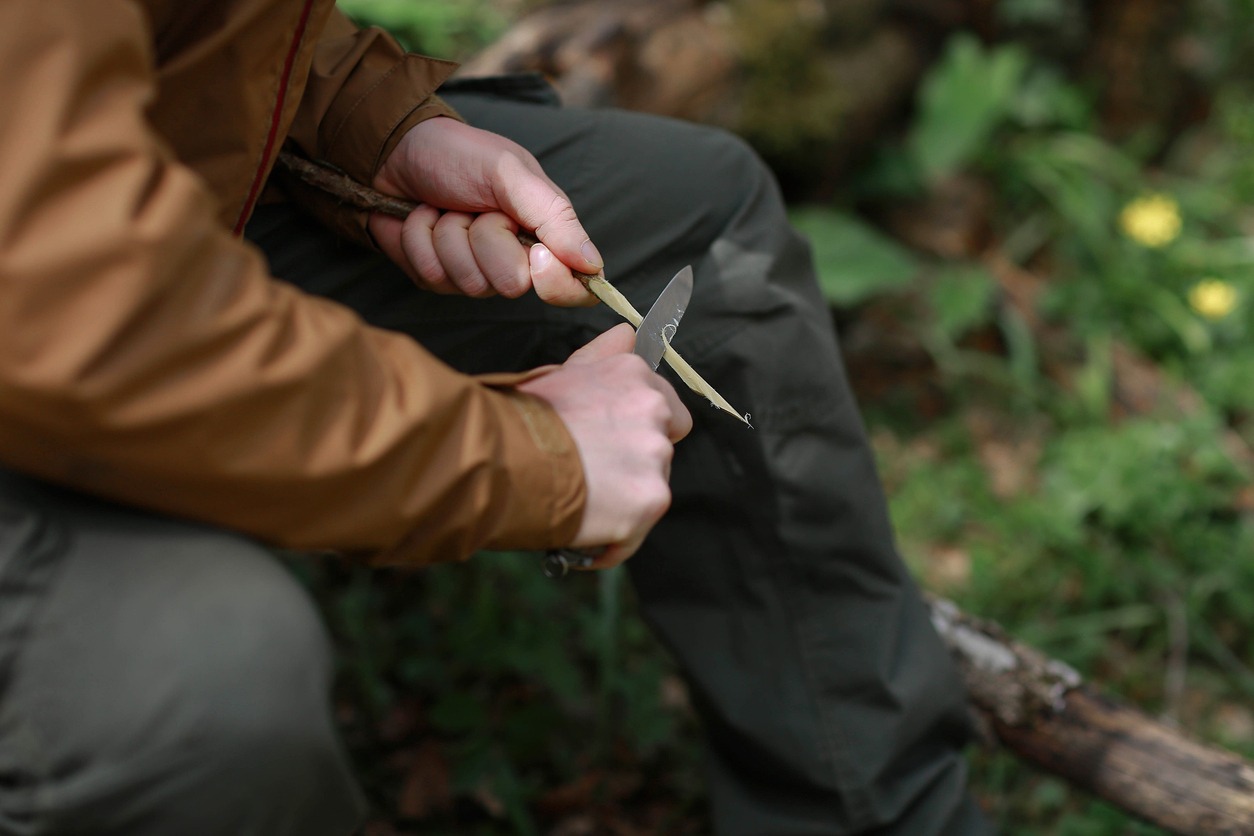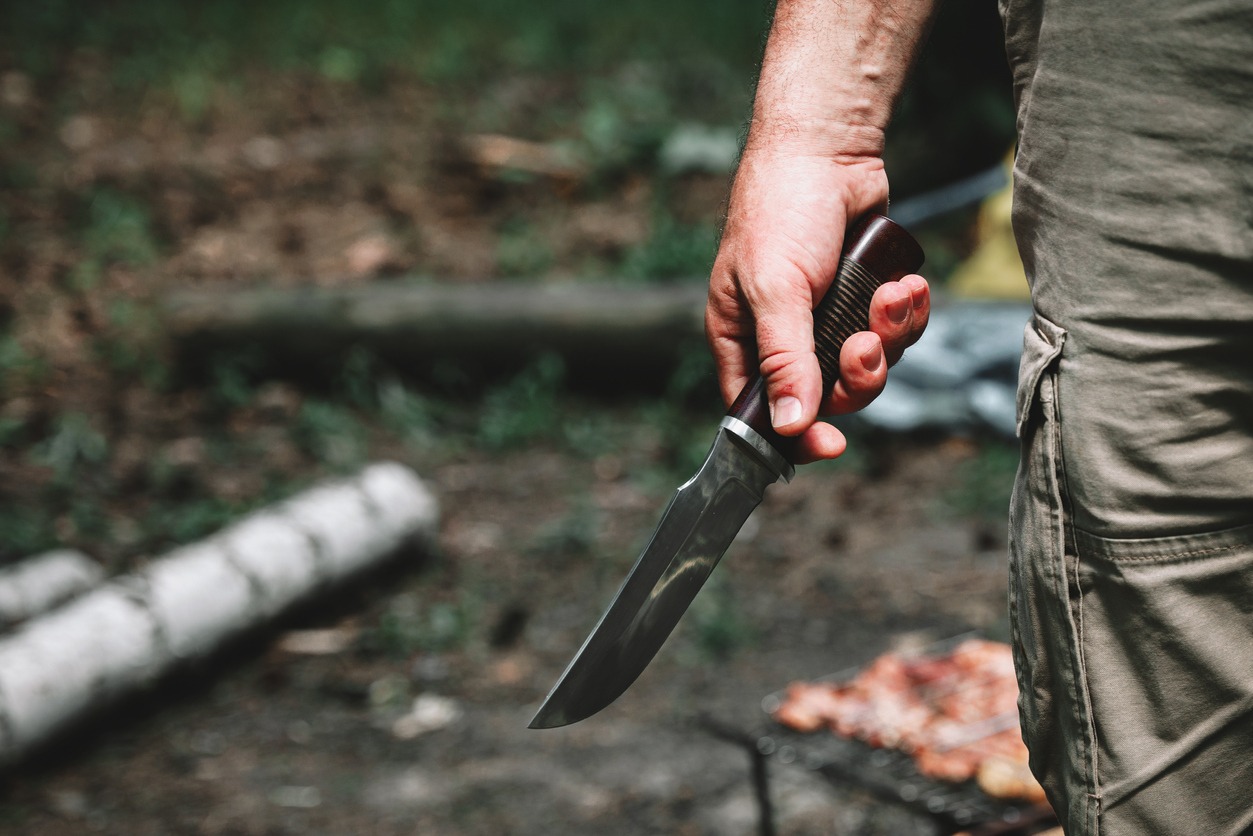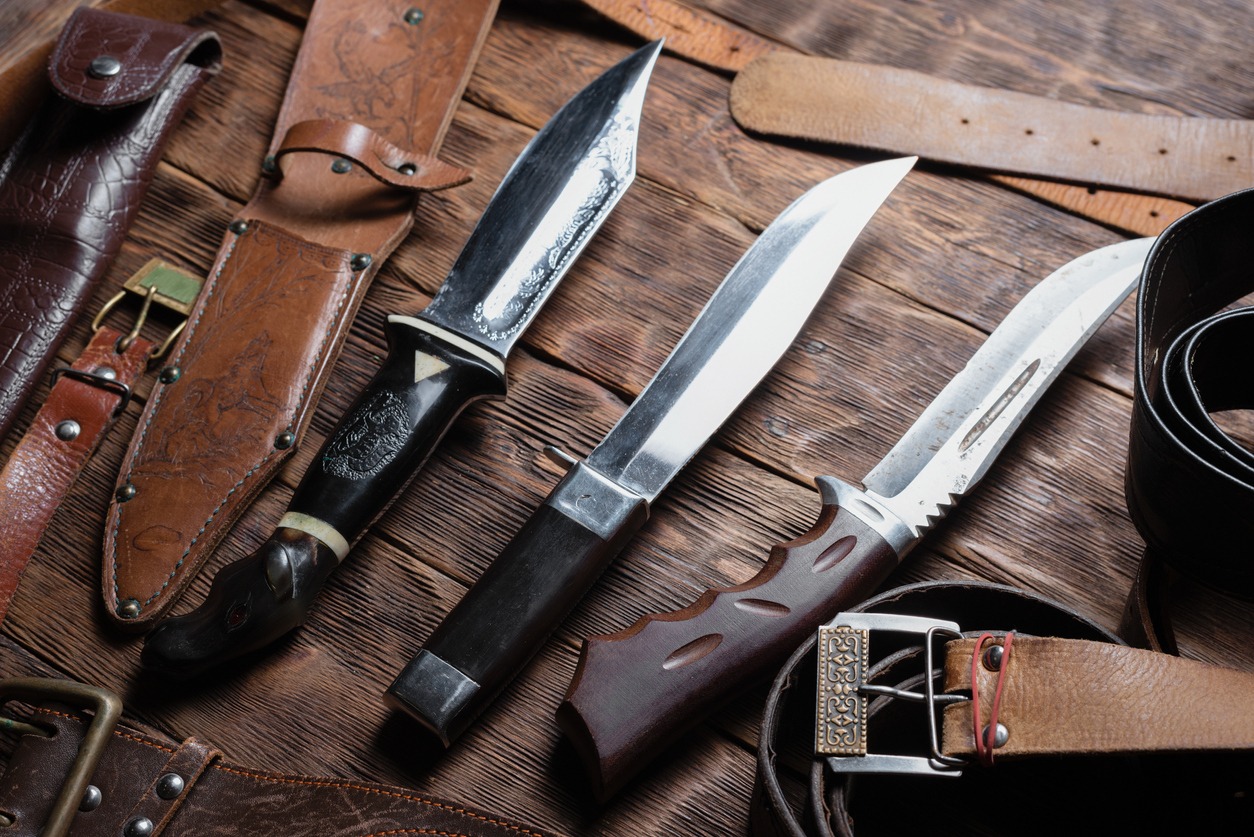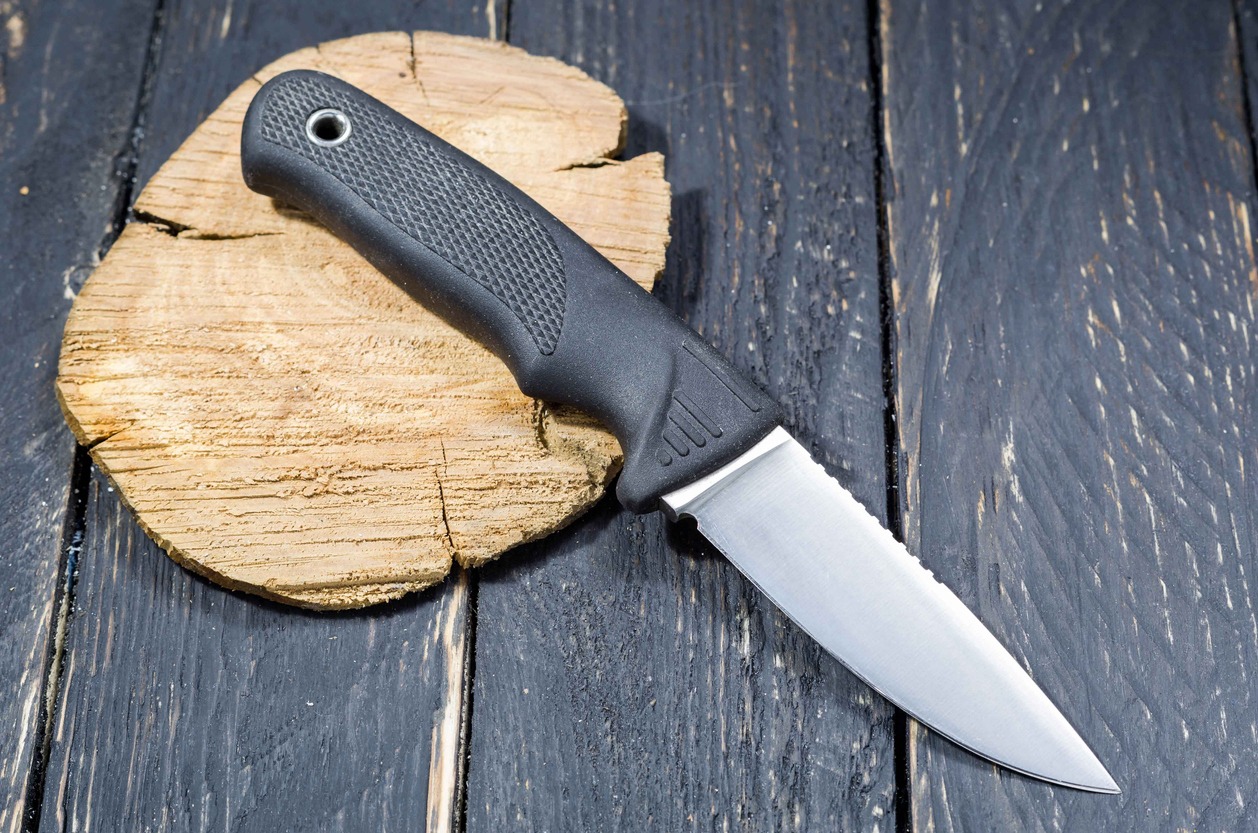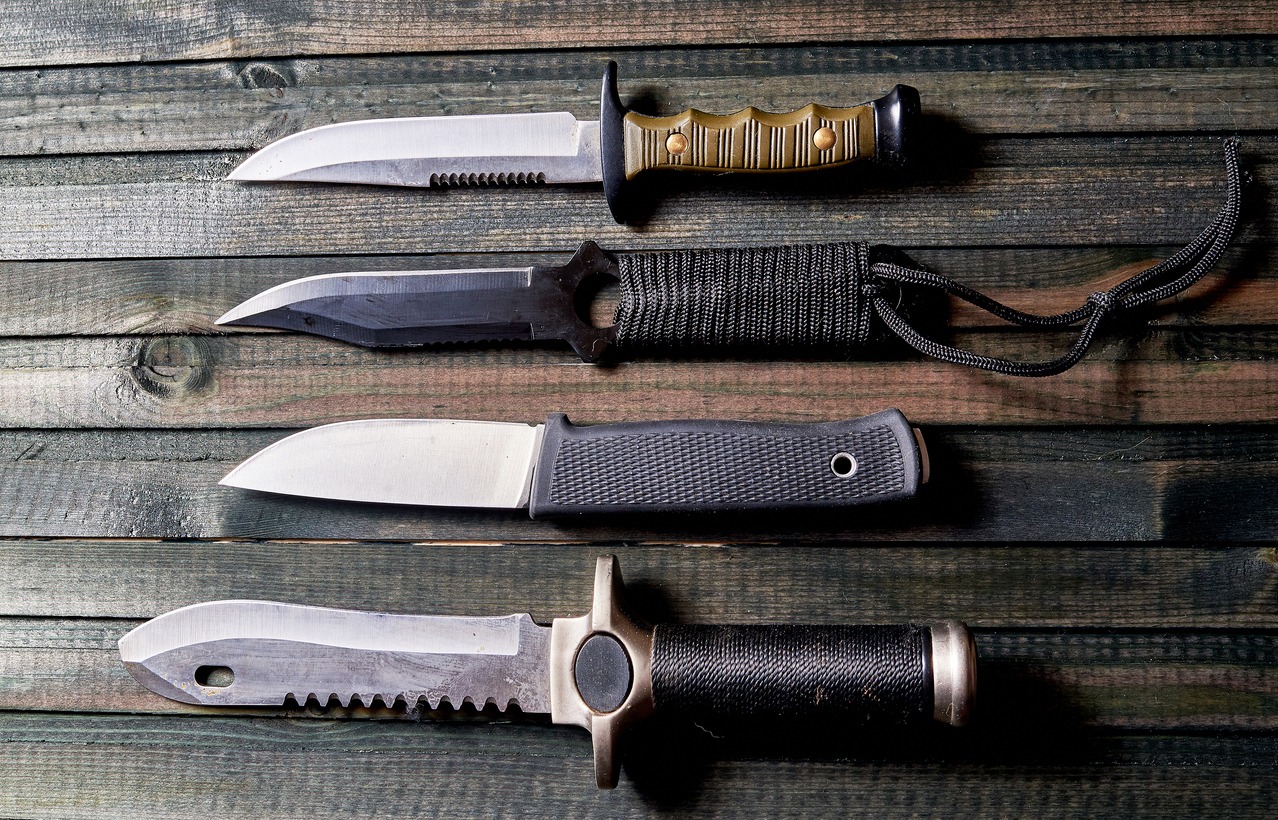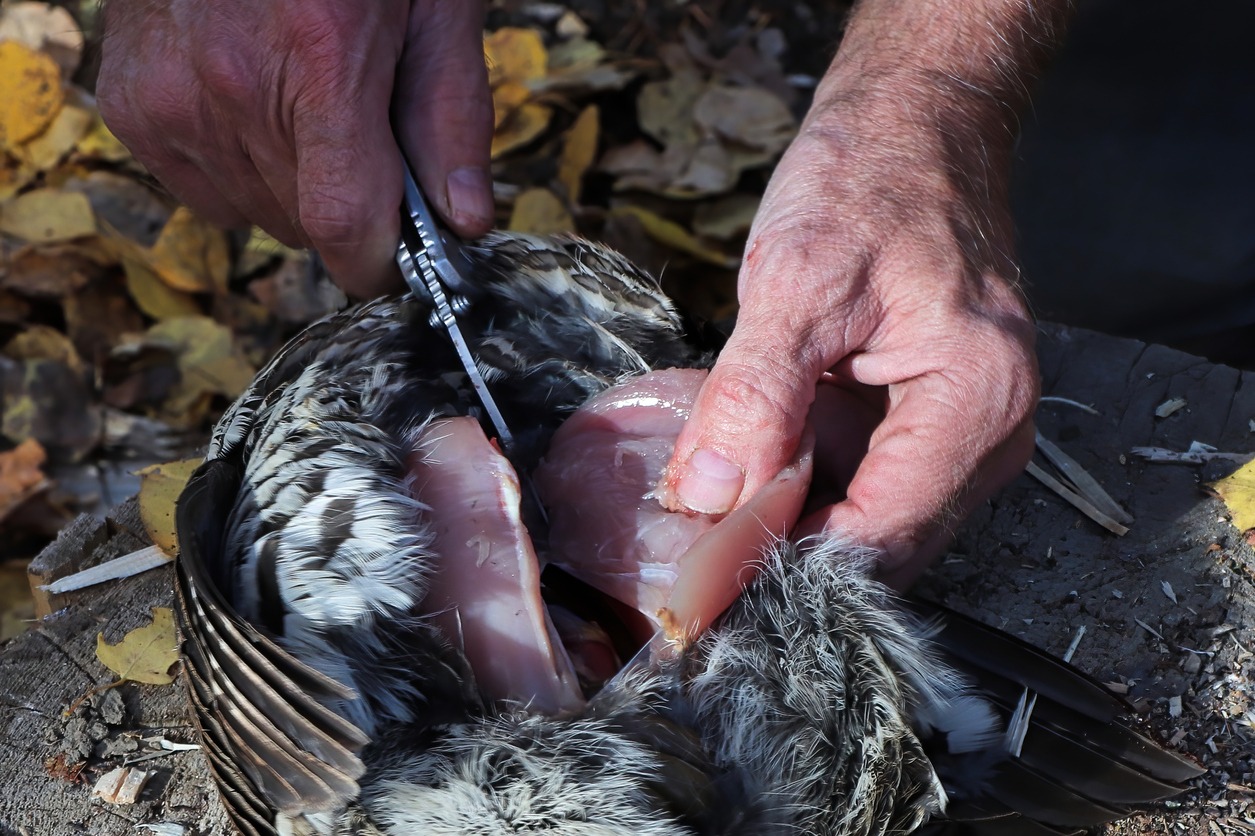Hunting knives have been used for over two and a half million years. Ever since man has been hunting for food, a tool has been needed to slice, cut, and skin the prey it captures. Over the years, humans have refined the hunting knife to what it is now. You can find knives with various blade shapes, cutting edges, and more. All of them are designed for different tasks in the hunting and cooking process.
If you are in the market to purchase a hunting knife, it is essential that you are familiar with what it is and the different types. Once you have sufficient information about all the different knives out there and how they work, you can easily choose one that fits you and your needs the best.
What Is a Hunting Knife?
A hunting knife is a knife that is used during hunting. You can use it for various purposes, such as butchering, skinning, and even field-dressing the game. Once you have taken the animal, you caught back home or to your campsite, you can also use it to cut up the meat and prepare it to be cooked.
A hunting knife has a long history; the first one was known to be used in Stone Age. The first ever hunting knifes used by man were made using either flint or obsidian. These knives had a sharpened edge on one side, much like knives you will find today.
Nowadays, you will find knives made using Damascus steel, which is extremely strong and remains sharp for much longer. Hunting knives made of this material have a beautiful wavy pattern on the blade, which is created by folding and welding multiple layers of steel together.
What Type of Hunting Knife Do Most People Need?
When purchasing a hunting knife, you may get confused between the various different types available on the market. The best way to know which hunting knife you need is to assess what you will use it for. If you intend to skin a deer or cut branches, you would want to get a specialty knife.
On the other hand, you will probably need a traditional fixed-blade hunting knife when you are out for an extended camping trip. This is because such knives can be used as a multi-purpose tool. Fixed-blade hunting knives are excellent at multiple tasks, such as skinning, field dressing, and other jobs.
Additionally, the type of hunting you indulge in also determines the knife you will need. If you hunt big animals, you will need a fixed-blade knife with a rugged handle. To skin such animals, you may need a drop-point knife, and so on.
If you hunt small animals like squirrels and rabbits, you will probably need a pocket knife with a clip-point blade and a fowl hook. Such blades are pretty helpful in gutting small birds. They are also lightweight, so you can easily carry them with your hunting gear.
Uses of Hunting Knives
Hunting knives have a variety of different uses, and here are a few things you can use them for.
| Use | Description |
| Gutting | Hunting knives are most commonly used for field dressing. This is the process of removing organs, which helps preserve the meat. A gut hook knife is perfect for this task. |
| Skinning | Skinning is the process through which the animal’s skin is carefully cut without tearing its muscles or abdominal tissues. Knives designed for skinning are usually short, thin, and curved. |
| Deboning | Hunting knives are also used for deboning, where the meat is removed from the bones of the game. |
| Butchering | Hunting knives are also used for butchering, which is when you cut up meat. Any multi-purpose knife can be used for this process. |
| Hunting | Hunting knives are also used in the process of active hunting. Hogs are often hunted using a hunting knife. Ideally, your knife should be straight and sharp if you intend to use it for this purpose. |
Types of Hunting Knives and Their Uses
Suppose you are looking to buy a hunting knife. In that case, it is essential that you know all the different types available on the market to choose a suitable one for your intended use. Although some types of hunting knives are specialized for specific tasks, you can find versatile ones that can be used for all your hunting needs.
1. Bowie Knife
A bowie knife is a large-fixed blade knife. It is generally longer than other kinds and has a broad blade with a sharp point. These knives are usually six to twelve inches long and have stour single-edged blades. Their blades are concave and curved, allowing them to be used for various tasks. A bowie knife is also known in the hunting community for its large cross-guard that helps protect your hand when you use it.
These knives are highly versatile and can be used for butchering and skinning. If you want, you can even chop wood using it. This makes them an excellent tool for those who want a multi-purpose knife.
2. Bushcraft Knife
A bushcraft knife is a multi-purpose hunting knife. Its design is very similar to that of a skinner knife. Still, these have slightly longer blades, making them suitable for hunting for larger games. Bush knives usually have a fixed blade that varies between three and five inches.
Bushcraft knives are perfect for when you intend to go on a multiple-day hunting trip to hunt larger game. Instead of carrying multiple knives, you can just carry one bushcraft knife. This will help you save space as this knife is equipped for boning, skinning, and cutting game.
3. Gut Hook Knife
A gut hook knife is a specialized hunting knife you can use to gut animals. To assist you in this task, it has a curved blade with a sharp point. This helps pierce the animal’s stomach so you can open it up and remove the guts.
A gut hook knife is essential if you hunt because it helps prevent you from getting your hands dirty and is an efficient way to gut an animal. Using a gutting knife, it takes seconds to gut an animal.
4. Buck Knife
A buck knife is a knife style that was popularized in the 1960s by Buck Knives, which made a large folding knife. These knives are perfect for hunting as they have a clip point. Initially designed for hunters, they are now often used as an all-around pocketknife. Still, you can use these when hunting for small games owing to their compact nature.
5. Larger Knives
Although most hunters prefer to use other, more modern tools for hunting, a hunting knife is still sometimes used. If you plan to hunt using a knife, you will need a large knife with a long, thin blade with a sharp point. Such blades allow you to pierce an animal’s heart without damaging other organs.
Larger knives are much easier to use and typically don’t destroy the skin or the meat around the heart, if you are accurate. You can also find larger knives with clip points. These have a unique appearance as it looks as if the front of the blade has been clipped off. Despite such an appearance, they are excellent for meat processing and piercing flesh.
Some larger knives also have a spear point. Such knives are often long and symmetrical, which allows you to pierce the heart with extreme precision and make clean cuts.
6. General-Purpose Knives
As the name suggests, this type of hunting knives are used for general purposes, including cutting, clothing, skinning, and more. These knives usually feature sharp double-edged blades with a very sharp point to stab the animal without applying much effort. General-purpose hunting knives are equipped with a blade of 4 to 5 inches in length. Its handle needs to be very comfortable, non-slip, and ergonomic to provide you with adequate control when hunting. Meanwhile, for self-defense, the butterfly knife is always the top choice for most people. A butterfly knife are pocket knives with counter-rotating handles that hide the blade within the grooves when closed.
7. Skinning Knives
So, you have hunted the animal you were after, now is the time to skin it. For this purpose, you need to have the best quality knife that allows you to cut off the animal’s skin cleanly without damaging the flash. The best skinning knife’s blade should be short, sharp, and slightly curved for better control. It is also important that the handle has an excellent non-slip grip to avoid any accidents.
8. Camping Knives
A majority of people think of a hunting knife as the type of knife used when camping. However, it is a different thing. Camping knives serve various purposes that also include a lot of hunting tasks. Therefore, it is designed to fill in for a hunting knife adequately.
A camping knife usually has a drop point style blade that can cater to various camping tasks.
9. Throwing Knives
Although this activity is seen as a sideshow, it has an important place in hunting. The art of throwing a knife is essential in order to scare away an attacker or to hunt a small animal that is right in front of you. You can’t just throw an ordinary knife to kill an animal. Therefore, a well-balanced knife is required for this form of sport.
10. Caping Knives
Caping means to skin the head or neck of an animal, such as a bear, deer, or a boar to use it as a trophy. It requires a knife that is specially designed to serve this purpose. These knives are short and sharp and can also be utilized for various other tasks as well.
11. Boning Knives
Once you have skinned the animal, the next important step is to remove the meat from the bones. For this purpose, a special boning knife is used that is very flexible and has a slim blade to debone effectively. This type of blade is similar to the one used for filleting a fish.
Parts of a Hunting Knife
1. Point
It is a part of the hunting knife where the blade meets the spine, forming a sharp end that is used to tip or puncture.
2. Belly
The curvature of the edge is known as the belly of a hunting knife. The bigger the belly, the more convex curve it has. This gives a hunting knife more cutting length, which comes at handy when skinning.
3. Edge
It is the working part of the blade that does the actual job of cutting.
4. Spine
The back of the blade is known as its spine. This part supports the edge of the blade and provides strength, heft, and stiffness to the overall structure of the knife.
5. Bevel and Secondary Bevel
Most hunting knives feature a bevel of 22° to 30° – it is the actual cutting edge angle. You shouldn’t confuse the bevel with the sharpening angle, which is usually half the size of the bevel. The secondary bevel of the knife lightens the blade, allowing for a sharper Primary Bevel.
6. Hilt
Guard or Hilt is a fitted crosspiece that helps keep your fingers from slipping down on the blade. Many hunting knives don’t have a guard as it can hinder your work when you are working inside the body of a large animal.
7. Choil
A choil is an indention on a non-sharpened part of the blade, near the hilt. It allows you to choke up on the blade for fine detail work.
8. Jimping
Jimping is a roughed up area on the spine of the blade, near the hilt. It provides a non-slip surface for your thumb to rest on when you need to choke up on your knife for fine detail work.
9. Pommel
The pommel isn’t often seen in outdoor knives. This part is an enlarged, or reinforced section at the but-end of the scales. It can be used to crack the skull, bones, ribs, and other tasks that require percussive force.
Note: Not all the hunting knives have all these parts mentioned above. It is up to you to decide whether you need a hunting knife with a special feature or not. However, one thing to keep in mind is that it is better to have a part on knife and not need it, instead of not having a part on a knife when you need it.
Types of Knife Tangs
Knife tangs is another crucial part of a hunting knife’s anatomy. This is the part of the knife that extends into the blade, hence your knife’s backbone. In simple words, a tang brings the handle and the blade together.
1. Full Tang
Full tang, as the name suggests, extends all the way back to the handle. Hence, it provides more grip, and this is the reason why it is the top-recommended choice of many serious hunters.
2. Partial Tang
Partial tang, unlike full tang, doesn’t fully extend to the handle. Therefore, knives with partial tangs might be lighter than the ones with the full tang – but nowhere near as strong. They can have various forms and sizes.
3. Tapered Tang
Tapered tang decreases along the length of the knife’s handle. There are different variations of a tapered tang, with the most common variation being where the edges taper towards the middle.
The best thing about a knife with a tapered tang is its blade having a perfect balance.
4. Skeletonized Tang
Skeletonized tangs have portions cut out from the center of the tang, removing materials and leaving holes to make the blade lightweight. Although these type of blades are a lot weaker than the rest, they make an excellent choice for throwing knives.
How To Choose the Perfect Hunting Knife
When purchasing a hunting knife, it is essential that you choose the right one so that you can use it for its intended purpose. Since there are various different kinds of knives out there, knowing the critical features that make a good hunting knife is essential. Here are a few factors you should keep in mind when purchasing a hunting knife.
1. Blade Size and Materials
When purchasing hunting knives, choosing the right size is a crucial task. Most hunting knives have blades that are somewhere between 3.5 inches to 6 inches. The blade size you need depends on the game you intend to hunt with it. Although you may be tempted to get a large knife, they waste a lot of meat and energy. It is better to purchase a smaller, well-shaped blade to give you better control. Smaller blades are also faster to use.
The construction of the blade is another important consideration. Modern hunting knives are made using various steels; some are better than others. Martensitic Stainless Steel is an excellent option for hunting knives as they are corrosion-resistant and also has an exceptional edge. Blades made of this steel are also affordable and have good durability.
The type of steel used in the blade of a knife also determines how well you can sharpen it and how long it will hold that edge after you use it a couple of times. The best blade materials have high edge retention, corrosion resistance, and water resistance and are a lot tougher. Vanadium steel, high carbon stainless steel, and medium carbon stainless steel are popular metals used to make hunting knives.
2. Flat-Grind vs. Hollow-Grind
The grind of a knife is the cut profile that leads to the knife’s sharp edge. There are numerous types of grinds used in hunting knives, but the most common are flat and hollow-grind.
A flat-grind knife has a consistent taper that runs from the spine to the edge and makes a V shape. These grinds offer a sharp cutting edge that you can easily shape after use, which is why it is an extremely popular grind in the hunting community.
A hollow grind curved from the thickest point of the knife to the edge, allowing the knife to be extra-sharp. Hollow-grind knives are typically used for slicing and cutting as they do a much better job than a flat-grind knife.
3. Blade Design
There are three main blade designs that hunting knives incorporate. These include drop point, clip point, or skinning blades. The blade design you should purchase depends on the kind of game you hunt for. If you hunt big game, you may want to buy a drop-point hunting knife. These blades have a thick, curved blade that is incredibly useful for skinning. You can use the entire edge, making your job much faster and easier. Additionally, you also lose a lot less meat.
A clip-point blade is a thin and flat blade, and it also has a well-defined point, unlike that of a drop-point blade. It can be used for the same tasks as a drop point blade but is not as efficient at skinning, gutting, and splitting. Such blades are much more helpful if you want a general all-purpose knife.
A skinning blade is designed specifically to have a more well-defined point, which makes it a lot more efficient at skinning, gutting, and splitting game. Due to their versatile nature, you can also use these knives for other chores, such as game cleaning.
4. Ergonomic/Non-Slip Handle
When purchasing a hunting knife, the handle must be made using high-quality material so that you are comfortable using it. An ergonomic and non-slip handle is a crucial feature that every hunting knife should have. Ensure that you can grip the handle well and that it feels both comfortable and secure.
FAQs
-
What is a suitable thickness for a hunting knife?
If you intend to use your hunting knife for various tasks at once, it is best to use a blade with a 0.175-inch thickness.
-
Should a hunting knife have a gut hook?
A gut hook is incredibly useful if you hunt big animals. They allow you to open the body cavity with ease, and you can also make long and straight cuts efficiently. Therefore, although gut hooks are not necessary, they surely make specific tasks a lot easier.
-
What do you look for in a hunting knife?
When purchasing a hunting knife, you should always consider the quality of the blade and how sturdy its handle is. You will also benefit from considering the blade design, the blade size, and the material of which the blade and the handle are made.
Conclusion
Choosing the right hunting knife can be challenging owing to all the different kinds of knives available on the market. When purchasing a hunting knife, the first thing you should do is consider how you will be using it. Once you know what the knife will do, you can choose a knife with the appropriate blade material, style, and size. This will help you purchase a hunting knife that best suits your needs.
